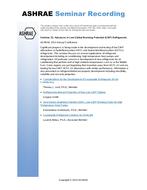In a recent field study of 86 new energy-efficient homes with relatively air tight construction in the Pacific Northwest, walls were opened up and unacceptably high wood-sheathing moisture contents were measured in numerous wall cavities. A separate field investigation, described here, was undertaken at one home in an effort to determine the cause. The moisture content of the wall sheathing was measured from the outside of the wall, both high and low, in every stud cavity of two walls (120 locations). Three locations were found with more than 40% moisture content, four locations with between 30% and 40%, and eleven locations with between 20 and 30%. Because evidence suggested that the source of the winter moisture buildup in the wood sheathing was moist indoor air migrating out through penetrations in the polyethylene air/vapour barrier, infrared thermography was used during house pressurisation and depressurisation to locate air-leak sites and paths. Numerous air leaks were observed both on the inside and outside of the exterior walls even though the house was found to be very air tight (1.2 ach at 50 Pa.) Many of the leaks resulted from improper sealing or poor workmanship and could have avoided. What is most important is that a definite correlation was found between the locations of many of the major air leaks and the locations of sheathing with high moisture content. In almost every one of the 8 places where the sheathing moisture content was more than 20%, there was a noticeable air leak in the wall cavity. Thus, the air leak on the interior portion of the walls introduced moisture into the tightly built wall cavities that could not dry out during the winter. Some suggestions are made to help minimise the effects of air leakage and keep tightly built wall cavities dry. A number of recommendations for further study are also presented.
KEYWORDS: site testing, air infiltration, leaking, moisture, air tightness, walls, buildings, cavity walls, low energy housing, external walls, measuring, timber framed construction, decaying, wood, housing
Citation: ASHRAE Transactions, vol.97, Pt. 1, New York 1991
Product Details
- Published:
- 1991
- Number of Pages:
- 8
- File Size:
- 1 file , 2.1 MB
- Product Code(s):
- D-18154

